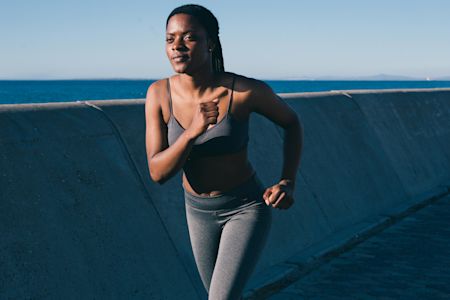“After a month, I’d lost half a stone and my pain lessened”
One year on The Body Coach app – and how it changed this woman's life.
Sign up for an annual subscription to The Body Coach app for just £69.99 (usually £89.99)

When we’re in a heatwave, the idea of exercising might sound like the last thing you want to do. (Nobody wants to get drenched in sweat before the workout even starts!)
But if you're keen to keep moving, the good news is you don't have to avoid it completely – you might just need to tweak a few things.
Heat affects your body more than you realise – yes, you sweat more, but your body is also working pretty hard to regulate temperature. This can cause you to feel tired more easily, and even make your heart beat a bit faster.
When you’re sweating too, it means you’re losing essential fluids and need to drink a lot more water than you usually would.
Research shows it can take up to two weeks for your body to adapt to exercising in the heat – which is why it’s important to take a slight bit of caution (as recovery could take a little longer than usual, too).
While there’s no legal maximum temperature limit to exercise, EMD-UK – the nonprofit body for group fitness classes – says temps above 32 degrees celsius can give “risks of heat exhaustion and heatstroke”, which must be taken seriously.
Staying active is still doable in the summer – so here are a few tips to take on board.
Hydrate like you’ve never hydrated before. This is the big one. Up your water intake before you exercise (at least a few hours) – and drink water every 15 minutes or so during the exercise.
“Drinking enough fluid is essential for maximising exercise performance and ensuring optimum recovery,” says the British Nutrition Foundation. “Exercising raises body temperature and so the body tries to cool down by sweating. This causes the loss of water and salts through the skin.”
“Generally, the more a person sweats, the more they will need to drink,” they say.
Think carefully about when you work out. Time your workouts for the cooler times of the day, e.g. in the morning (before 10am) or evening (after 6pm) to avoid the hottest heat and reduce risk of dehydration.
If you exercise at home and are lucky to have cooler rooms in the house, that’s your best bet – although you still might want to avoid the hottest time of day to get moving.
If you’re exercising outside, it’s even more of a reason to aim for the cool morning or evening, over a lunchtime jog.
Wear clothes that’ll keep you cool. What you wear can make a big difference, especially if you’re heading outside. Light, breathable fabrics can reduce the sweat and prevent you from getting hotter than you need to.
Choosing loose-fitting clothing is often best too, as more air can get in and around and keep your body cooler when you’re moving.
Know what warning signs to look out for. When you’re exercising in the heat, you may to get specific warning signs telling you when it might be best to stop or slow down: dizziness, higher heart rate than normal, unusual weakness or fatigue, or a headache.
If you’re concerned, stop. You know your body best. And if all else fails, find the nearest place with aircon and camp out there!
This article was written by The Body Coach content team.